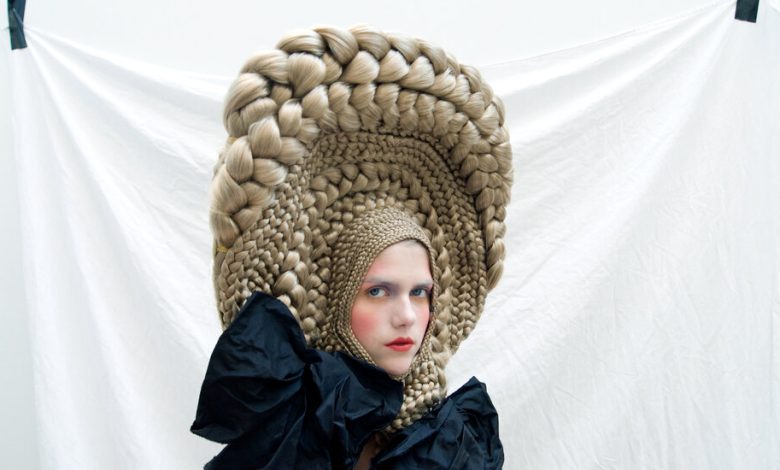Big Hair and Big Thoughts at a Paris Museum

On a recent afternoon, at an exhibition at the Museum of Decorative Arts, in Paris, two women peered into a glass case containing Andy Warhol’s wig. Mounted alongside it were more elaborate wigs belonging to less famous men.
One of the women had what is known as the “Speak to the Manager” haircut: chin length at the front but then angled steeply backward, so that the hair at the crown is short enough to be fanned out with gel. As is almost always the case with a Speak to the Manager, the cut was accentuated by deliberately obvious highlights, striping tigerishly up toward the crisp bristle atop the head. The other woman’s hair was a rich, soft brown, hanging to her shoulders in a well-cut bob.
The wig, which hung limply above a label stating that it had traveled to Paris from the Andy Warhol Museum in Pittsburgh had a cheap, synthetic shine to it: an item that should have been innocuous, but was so evocative of its owners’ personality that it seemed as if it were about to crawl off its display board, sidle up to one of the older, less well-known wigs in the cabinet, and start making undermining remarks. The woman with the expensive hair shuddered and moved on after a few seconds.
The woman with the Speak to the Manager stayed put for a little longer. Later, she was heard to whisper “Oh my god” in front of a cabinet containing a wooden carving of a man’s head, with glaring eyes and an assertive chin. Alongside the cabinet was a label explaining that this was once a stand for a wig belonging to King Charles II of England, woven from his mistresses’ pubic hair, as was tradition in 17th-century libertine circles. Unfortunately — or fortunately, depending on your feelings about the existence of such an item — the wig itself was “probably destroyed in the 19th century.” (The label gave no further explanation as to why.)
The exhibition, called “Des cheveux et des poils” in French, which means something like “Hair and Fur,” runs through Sept. 17 and takes up both floors of the museum’s main gallery space. It is billed as delving into “the hairy history of hair from the 15th century to the present day,” with over 600 objects and art works gathered from museums around the world, exploring the evolution of women’s hairstyles, the question of removing facial and body hair for men and women, hairpieces, hair dye, razors, hair dryers, cultural attitudes to baldness, “the pixie and sauerkraut of the 1960s” and the “hurluberlu” of the mid-17th century. Hair, hair, hair.
When first entering the space — through a doorway printed with a close-up of a rugby player’s rampant chest hair from a 1912 painting by Eugène Pascau — the prospect of so much hair-themed material ahead seems something of a chore. How long can thoughts of hair occupy the attention, really? How interesting can 600-plus hair-related objects actually be?
Yet hair — and what we think it says about ourselves and others — turns out to be one of the interesting subjects in the world, and 600 objects isn’t nearly enough. An exhibition about hair is also an exhibition about self-presentation and self-perception, difference and hierarchy, race, religion, control, disgust, childhood, adulthood, masculinity and femininity.
Take Louis Leopold Boilly’s “Portrait of Madame Fouler”(1810), in the first room of the show. A young woman with an arrestingly chic haircut — cropped, curly and imminently due a revival, if anyone is looking for an image to show their hairdresser — looks off to one side with a halfhearted smile. The accompanying label explains that the seemingly anachronistic shortness of Madame Fouler’s style, known as the “Titus,” had its origins in the “bals des victimes,” dances that were held during the French Revolution for the relatives of people whose life was cut short by the guillotine. There is a description from a contemporary witness, who recounts that some of the balls required that attendees “cut their hair short around the neck, just as the executioner cuts the hair of victims.” A haircut is an announcement, as Madame Fouler knew.
A few rooms on, a young man with exuberant curls held away from his face with a scrunchie stood in front of a late 18th century etching, Jean-Baptiste Huet’s “Desolation of the Daughters of Joy,”which illustrates the effects of a 1778 police ordinance intended to restrict prostitution: Bewigged magistrates stand on a platform above groups of weeping young women with shiny bald heads, shaved after the girls had been picked up by police on the streets of Paris. (Frenchwomen accused of collaboration received the same punishment in World War II.)
Another etching, Sebald Beham’s “Scene From the Oven” from the mid-16th century, depicts a naked woman seated on a bench in a public bath house, apparently fresh after having her pubic hair shaved by a bath house employee — “either with a razor, or using limestone and arsenic,” a label says. A young woman with cherry red dyed hair stopped to sniff a scent created especially for the exhibition, meant to replicate the smell of 18th century wig powder, which was strongly perfumed to mask the odor of the grease applied to the hair. It smelled like ancient candies rattling around in the handbag of someone’s grandmother.
Upstairs, a bald man paused in front of a cabinet containing bronzed replicas of some of the most important styles created by Laurent Gaudefroy, a celebrity hairdresser known as “King of the Chignon”: smooth, ornate updos, calling to mind Elizabeth Taylor in her prime caftan years, sailing across a crowded bar with a cigarette holder in one hand, martini in the other.
“These are for people with way too much time on their hands,” he said to his companion, who had braids reaching almost to her waist. She nodded. An hour and a half later, they were still at the show.
Des cheveux et des poils
Through Sept. 17 at the Museum of Decorative Arts, in Paris; madparis.fr.




